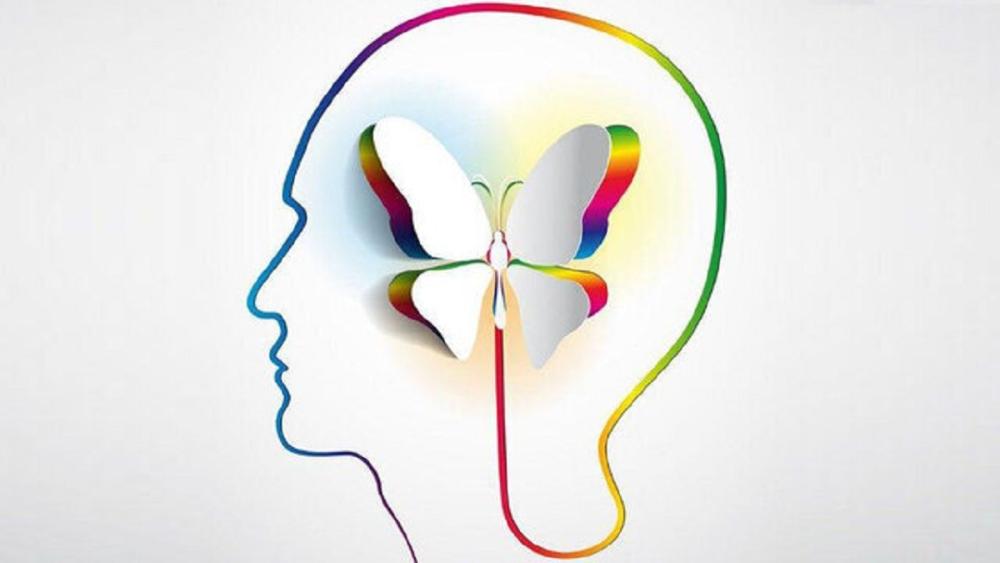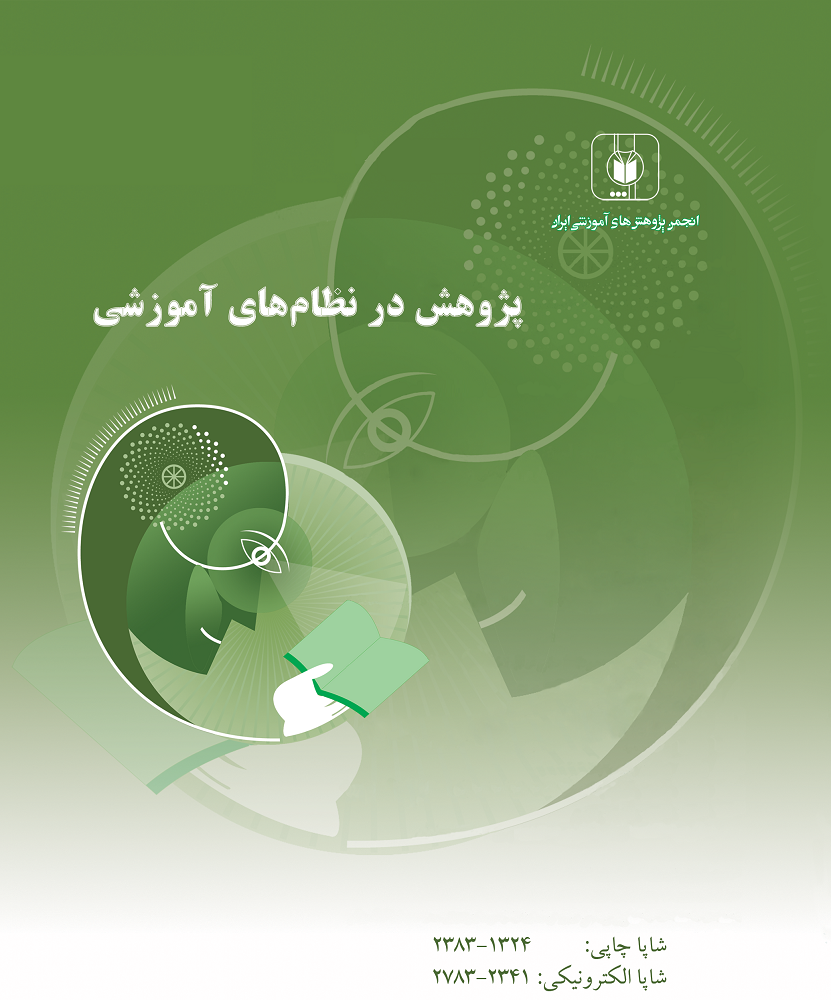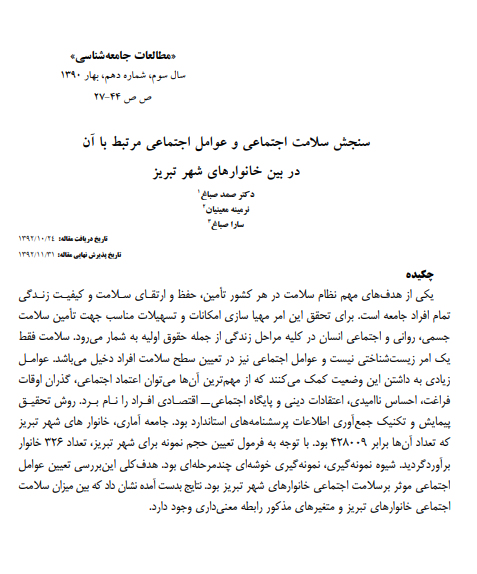Social health and its indicators - کرسی یونسکو در سلامت اجتماعی و توسعه ucshd

Social health and its indicators
Social health and its indicators
01 01 2024 10:33
News Code : 38807
View Count : 794
The evening meeting of the Medical and Health Sociology Group entitled "Social Health and Its Indicators" was held on Sunday, December 8, 2013,
The evening meeting of the Medical and Health Sociology Group entitled "Social Health and Its Indicators" was held on Sunday, December 8, 2013, at the Pajhwok Andishe Moasar Institute, with the presence of Dr. Shirin Ahmadnia, Maryam Mehrabi, Mehrdad Ehtari, and Dr. Mir Baha.
Dr. Ahmadnia, a faculty member at Allameh Tabatabaei University and director of the Department of Medical and Health Sociology of the Iranian Sociological Association, presented his speech on the topic of "Social Health: An Interdisciplinary Issue" as an introduction to the discussions that other speakers at the meeting were going to present on social health indicators. He thanked the speakers at the meeting, who presented interdisciplinary specialized perspectives, for their presence and participation in this panel and said: According to common definitions in scientific literature, health has physical, psychological, and social dimensions. However, in society, most people focus more on its physical dimension and identify health as synonymous with it. As a result, when talking about health behaviors to maintain or promote health, among the examples that are most associated in the public mind, we can mention the common recommendations regarding the necessity of sports and physical activities, the importance of healthy nutrition and the need to avoid health abuses, the need for regular checkups and medical care, which people are more familiar with. But the reality is that health encompasses more than just the physical dimension. In fact, health is the result of socio-economic and cultural conditions and quality of life, and is closely linked to economic stability, neighborhood and housing conditions, health care, social and cultural context, and levels of education and awareness.
He continued by giving an example of AIDS prevention, which is considered a purely physical problem, emphasizing the need for multiple and multi-level measures and interventions, such as individual awareness and education, individual influence and interaction with peers, free health services, formal education policies, educational institutions, and other such measures, to achieve success in reducing the risk of contracting this disease and effective prevention. He added: "We should not think that in order to combat AIDS, which is considered a purely physical disease, we should only seek drug treatments and improve the performance of doctors. Rather, this disease also requires political, social, and cultural measures to be implemented in order to be controlled in any society. AIDS, like many other diseases, can only be controlled and the incidence rate reduced through social, cultural, and economic measures." The determining factor in the increase and decrease of AIDS lies in the social context of people's lives in any society, not in the hands of doctors. This factor is largely related to the second and third dimensions of health, namely its psychological and social dimensions, that is, what happens in the relationship between individuals and in society and in the policy-making arena.
Therefore, the fundamental assumption is based on the fact that there is an interactive relationship between the "individual" and the "social environment" and that the behavior of individuals is influenced by and also influences their social environment. In other words, humans affect the health of other people with their beliefs, thoughts, advice, emotional support or, conversely, sabotage and negative labeling and stigmatization, which, as a result, leads to neglect and lack of necessary support for patients even in the close circle of family members, friends, peers, colleagues, neighbors and even among health or treatment service providers, and makes affected people doubly vulnerable, suffering and disabled.
Dr. Ahmadnia, raising the question of who should be considered a health care provider and what specialization, said: In addition to the physician, a set of determining factors and members of an interdisciplinary set of specializations, including sociologists, psychologists, economists, as well as policymakers, business owners, government officials, family members, and other people in the surrounding environment, are determinants and influencers of the health status of individuals in every society, and health is the result of economic, social, and cultural living conditions in all its dimensions, and not just the result of the performance of doctors. The concept of social health has been identified and defined by experts at both the individual and societal levels. It can be defined in terms of the degree of adaptation and harmony of the individual with society, in terms of the exchange of social support, and the manner and quality of the performance of ordinary roles of individuals in society. In other words, social health is understood when an individual can get along well with others, easily make friends with others, maintain their friendships, and be considered trustworthy in the eyes of others. On the other hand, this concept can also be defined at the level of societies, meaning that a healthy society (from the perspective of social health) can be considered a society that provides equal opportunities for all to access and enjoy essential goods and services for citizens, whose characteristics include the rule of law, equality in the distribution of wealth, public access to decision-making processes, and different levels of social capital such as social networks and mutual trust.
In the continuation of this meeting, Maryam Mehrabi, a social researcher and expert at the Ministry of Health, discussed the topic of “Social Health: Healthy Person - Healthy Society” and said: Social health is a relative concept, and therefore, choosing an appropriate standard is a challenge, and if it is considered from a sociological approach, it can be recognized as an indicator of the efficiency or inefficiency of social structures. Social health can be derived from sociological and psychological concepts in terms of social adaptation. Adaptation can be assessed subjectively or in comparison with normal social expectations, and social health can be related to the desired social acceptance of an individual in society. The World Health Organization considers social health at the individual level and in three dimensions in relation to other people in society and social institutions, which are: social communication and interactions, individual and social adaptation, and playing a social role.
Mehrabi continued: Social experts consider social health at the community level and consider it as a healthy society with characteristics such as equal opportunities in access to basic goods and services.
He also pointed to the internal and external variables affecting social health and considered it to overlap with human development, social capital, social determinants of health, and quality of life. He stated: Social determinants of health have five key areas, which are: economic stability, education, social context and communities, health and hygiene, and neighborhood and environment, which are methods of promoting health through the development of healthy lifestyles by empowering people through awareness-raising, as well as social action for social health and influencing community policymakers.
At the end of his discussion, the speaker of the meeting presented a report on the current situation in the country, which noted the low level of participation in voluntary activities based on studies examining social capital, and that it seems that social health in Iran is declining.
The speech by Dr. Fariba Mirbaha, sociologist and researcher at the Center for Health Knowledge Exploitation at Tehran University of Medical Sciences, was dedicated to the topic of "Social Health Indicators Project", which is the title of a research project that is being carried out by the Office of Mental, Social and Addiction Health at the Ministry of Health.
After introducing the common perspectives and assessment of social health, Dr. Mir Bahaa introduced the method and steps of implementing the aforementioned project as follows: searching the literature, reviewing existing conceptual models, extracting indicators from the literature, intra-group agreement on a conceptual model, matching indicators with the conceptual model, initial prioritization of indicators, receiving feedback from experts, final prioritization of indicators, and standardization of definitions.
He added: The conceptual model and indicators were obtained from a review of sources, and the emphasis was on indicators that can be used to measure social health. Finally, the final conceptual model includes the distant determinants or social level (social, economic, cultural, political, environmental, and health system) and the close determinants or individual level (behavior and lifestyle, biological and genetic, age, and gender) that affect social health and will have consequences or results at the individual and social levels.
Dr. Mehrdad Ehtari, psychiatrist and deputy director of the Prevention Development Center of the National Welfare Organization, another speaker at the meeting gave a speech on the topic of "Proposal for the Development of Social Health Indicators Dynamics" and said: Social health has been considered as a healthy society in which behavioral, institutional, and governmental indicators are intertwined and will be a reflection of the mutual rights of the individual and society. When one looks at the list of social issues (drugs, suicide, taxes, media, population, human rights, attacks on Muslims, and such), the difficulty of defining indicators will be more understood. The disagreement about whether or not a human being is fundamentally selfish determines the scope of his limitations. This concept immediately goes back to the issue of ethics in the sense of internalizing values that protect the interests of society. Traces of the contradiction between the interests of society and the individual, as well as solutions to resolve this conflict (provided that it is accepted), can be recognized since the time of early humans. Rituals are considered as a way to internalize and predict the results of behavior up to the rights of citizenship in the present era. There is disagreement on whether humans are inherently social or isolated creatures, and there is not much agreement even on the concept of "inherently". But during the process of evolution, human beings have certainly come together to create a sense of peace and security against peripheral issues. The reason for the stability of these groups, which were later organized due to relationships and rules and took the form of society, is to preserve this feeling of peace and happiness. Therefore, the most important indicator of social health can be related to this main task. Creating this feeling depends on the degree of ability within and around the individual to exercise his desires without fear of the consequences. By creating laws, society controls the limitations that are related to the interference of unlimited desires of individuals. Also, with a deeper understanding and due to the existence of peace in society, the perception of the connection of common and mutual interests has increased, and moral-social-emotional concepts such as social capital are formed, which increase peace. Issues related to these restrictions - freedoms - are also considered indicators of social health.
Dr. Ehthamari added: The issue of whether a person should serve society or society should serve man, and the ratio and balance between these two bases, is the basis for defining social health. The balance between these two bases is achieved through concepts such as citizenship, game theory, competition, and elections. However, this balanced social moral situation related to restriction-freedom requires individual and social bases that enable the realization of the power of choice. In order to expand the scope of his choice, an individual has the right to ask society to provide him with more opportunities and authority, and society also has the right to ask its people to make more efforts and raise its expectations from individuals to create the possibility of choice for its other members. The indicators related to these issues are also considered as social health issues. However, it is necessary to define the indicators in this area dynamically and in a spectral and comprehensive manner. This means that using the same indicators in two times or two places, either in terms of definition or in terms of quantity, may not be correct. These indicators change based on the type of desires and the individual's freedom of choice. The fuzzy model of social health definition is based on the interaction of the type and intensity of the desired behavior of individuals in a community with each other and with society.
In this way, a healthier society is one in which the community expects its members to show more of their talents, demands more effort from them, and people achieve more opportunities and become more empowered. The interaction of these factors leads to the prevention of government or specialized tunnel vision, regardless of the desires of individuals.
Suggestions (as examples) for indicators that can be proposed in this model:
High expectations of individuals in society: Healthy people of working age continuously do productive work (the key point here is productive work, which should be defined through democratic institutions, civil society institutions, and a government that supports justice in human relations).
Expectation of effort: Job productivity is high.
Equal opportunity: All individuals have equal educational opportunities to improve their knowledge and skills.
Empowerment: All individuals are able to exercise their desired choices within the society of which they are a member, to the extent permitted by law (the law provides the least possible hindrance, both through democratic processes and through the production and expansion of social empowerment).
Accordingly, a proposed definition of social health is: “a state in which the capacity of the community to provide authority and well-being to its members is enhanced, and in which individuals contribute to the promotion of this capacity through health behavior, health norms, and role playing.”
In this way, the components of social health can be considered to include the following main groups:
a) ethical responsibilities; b) development of citizenship; c) freedom to participate; d) good governance;
e) community-based structures.
In this case, the classification of indicators for determining social health can be determined dynamically on this basis: a) Behavioral indicators monitor the behavior of individuals (respect for the rights of others); b) Institutional indicators monitor the goals and behavior of institutions. Here, creating a sense of social support (welfare and empowerment) is important. (Insurance for all members of society); c) Government indicators monitor policies and governance (government elected by the people).
Suggestions:
- Efforts to mathematically model the identification of conditions and interventions in social health
- Establishment and expansion of an appropriate structure for empowerment
- Efforts to approximate national and international definitions and indicators in the field of social health as much as possible
- A far-sighted look at the health status and finding the role of social health
- Development of flexible mechanisms for public information on the status of social health, risk and protective factors, and the role of individual and social decision-making in changing them






